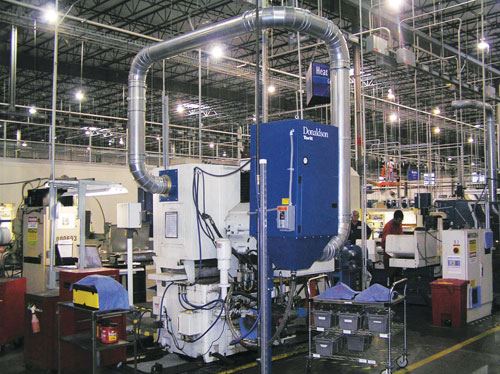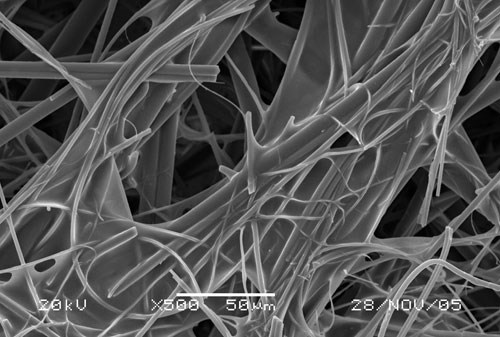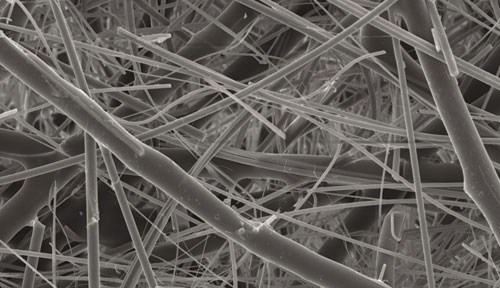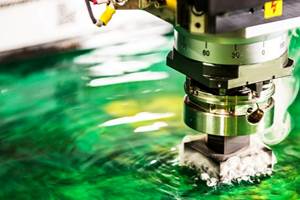Mist Collector Design Fundamentals
Consider design differences when determining what style of mist collector is best for a given application.
Manufacturers use mist collectors on machine tools to provide cleaner air and a better working environment for shopfloor employees. Mist collectors minimize the adverse effects of exposure to metalworking fluids and help shops comply with indoor air quality standards. They also improve in-process part quality by keeping work surfaces clean while reducing maintenance and housekeeping costs.
In general, all mist collectors coalesce tiny mist droplets into larger ones and drain the collected coolant to prevent the filtration system from becoming plugged. (Droplets generated during milling and turning operations range in diameter from 2 to 20 microns for water-soluble coolants and from 0.5 to 10 microns for oil-based coolants.) However, there are differences in the ways that particular mist collector systems remove droplets from an airstream. It’s important to consider these distinctions when determining what design is best-suited for a given application.
One common type removes droplets via electrostatic precipitation. These units work by drawing mist-filled air through an ionizer that gives each droplet either a positive or a negative charge. The charged droplets are then captured by collection cells that use alternating high-voltage and grounded plates to attract the charged droplets. The droplets coalesce on the plates and drain out of the collector. Electrostatic precipitation units are advantageous because there are no filters to replace, they consume a relatively low amount of electricity and they offer high efficiency when fully cleaned. That said, they have fallen out of favor with some due to their frequent, arduous maintenance routines. Their internal components must be kept meticulously clean in order to efficiently charge and capture droplets.
Another design relies primarily on inertial separation to remove droplets from an airstream by diverting the airstream around a collection surface inside the unit. Because the droplets in the airstream have momentum, they continue on their path and impact the surface, ultimately coalescing with other droplets and draining. Inertial separators typically do not have primary filters that need to be changed. However, they require regular maintenance to clean contamination from the components. In addition, inertial separation tends to work better on large droplets than small ones because bigger droplets have more mass and momentum. This increases their chance of impacting the collector surface. Inertial separators have sub-par efficiency when droplets are smaller than 2 microns in diameter.
A third type of mist collector uses fibrous filter media to remove droplets. Droplets adhere to the fibers in the filter media and coalesce with other droplets. When a droplet is sufficiently large, gravity pulls it down the fiber to drain. The challenge using this type of collector is balancing the need for both high efficiency and effective draining. High filtration efficiencies can be achieved using small fibers. However, small fibers typically require resin to hold them together, which prevents coalesced droplets from draining effectively. Therefore, filter media using small fibers can become easily plugged with trapped liquid. Conversely, large fibers have good draining characteristics but can compromise the ability of the media to capture small mist droplets.
Such a circumstance is often mitigated by using layers of fiber media. A pre-filter layer with large fibers, mesh or screens captures and drains large droplets while a second or primary layer with smaller fibers accumulates most of the remaining droplets. An optional third layer uses a HEPA or DOP filter for high-efficiency removal of sub-micron-sized droplets. However, if any of these layers are working poorly, the entire mist collector will be ineffective.
This prompted Donaldson Company, a provider of filtration systems and replacement parts for industrial and engine applications, to develop a more consistent way to realize both high efficiency and effective draining using fiber media. The company’s Synteq XP media is an engineered blend of small and large fibers that uses a proprietary, resin-free bonding system. Heat-fusing the surface of larger binding fibers to surrounding micro-glass fibers provides a stable pore structure that improves unit performance and life because no resin blocks the pores. With no resin to compromise effective draining, the media’s small fibers offer higher filter efficiency. In turn, its larger fibers provide good overall support for the structure while maintaining clear drain channels.
About the author: Karen Geronime is a Torit Product Manager at Donaldson Company, Inc.
Related Content
STLE Opens Registration for 2024 Annual Meeting
The Society of Tribologists and Lubrication Engineers’ 2024 STLE Annual Meeting & Exhibition will take place May 19-23 at the Minneapolis Convention Center in Minneapolis, Minnesota.
Read MoreOelheld Coolant Increases Metal Removal Rates
The odorless coolant is said to offer increased removal rates, lower electrode wear, excellent surface qualities, lower refill quantities and longevity to provide lower overall operating costs.
Read MoreFortech Synthetic Coolant Enables Bio-Stable Metal Removal
Fortech’s TechKool FT4000 synthetic coolant is formulated to reject tramp oil that can cause smoking or misting and premature spoilage of coolant.
Read MoreVomat Coolant Filters Provide Precise Temperature Control
The company’s filters ensure a continuous supply of clean oil for microtool grinding applications.
Read MoreRead Next
The Cut Scene: The Finer Details of Large-Format Machining
Small details and features can have an outsized impact on large parts, such as Barbco’s collapsible utility drill head.
Read More3 Mistakes That Cause CNC Programs to Fail
Despite enhancements to manufacturing technology, there are still issues today that can cause programs to fail. These failures can cause lost time, scrapped parts, damaged machines and even injured operators.
Read MoreObscure CNC Features That Can Help (or Hurt) You
You cannot begin to take advantage of an available feature if you do not know it exists. Conversely, you will not know how to avoid CNC features that may be detrimental to your process.
Read More




















.png;maxWidth=300;quality=90)








